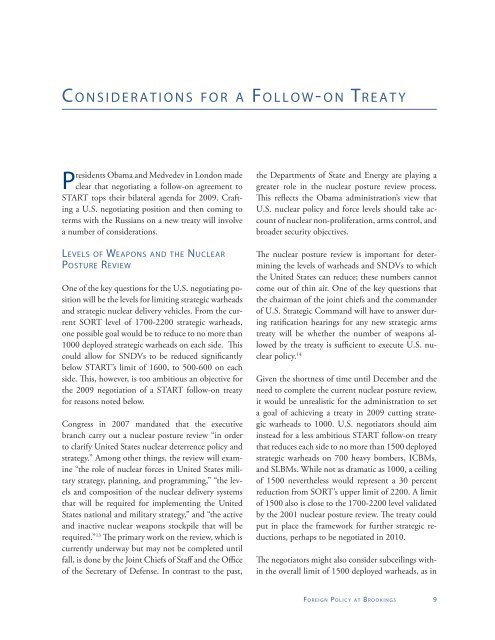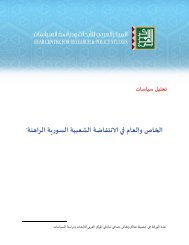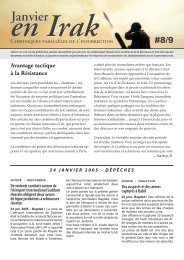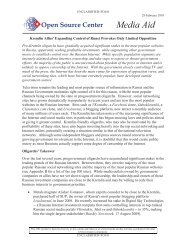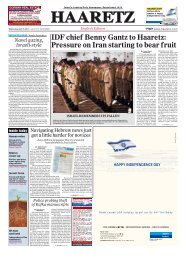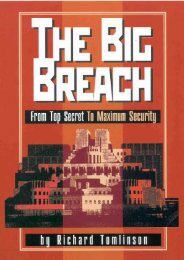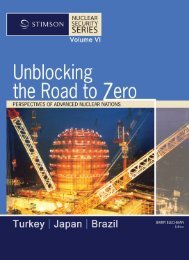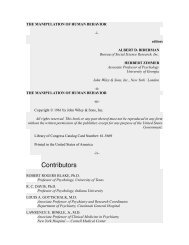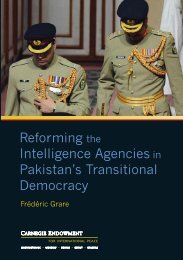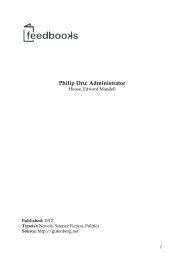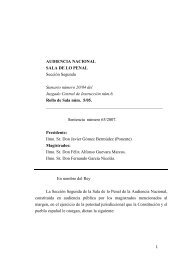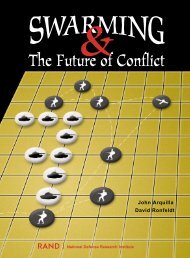C o n s i d e r a t i o n s f o r a Fo l l o w- o n Tr e a t yPresidents Obama and Medvedev in London madeclear that negotiating a follow-on agreement to<strong>START</strong> tops their bilateral agenda for 2009. Craftinga U.S. negotiating position and then coming toterms with the Russians on a new treaty will involvea number of considerations.Levels of Weapons and the NuclearPosture ReviewOne of the key questions for the U.S. negotiating positionwill be the levels for limiting strategic warheadsand strategic nuclear delivery vehicles. From the currentSORT level of 1700-2200 strategic warheads,one possible goal would be to reduce to no more than1000 deployed strategic warheads on each side. Thiscould allow for SNDVs to be reduced significantlybelow <strong>START</strong>’s limit of 1600, to 500-600 on eachside. This, however, is too ambitious an objective forthe 2009 negotiation of a <strong>START</strong> follow-on treatyfor reasons noted below.Congress in 2007 mandated that the executivebranch carry out a nuclear posture review “in orderto clarify United States nuclear deterrence policy andstrategy.” Among other things, the review will examine“the role of nuclear forces in United States militarystrategy, planning, and programming,” “the levelsand composition of the nuclear delivery systemsthat will be required for implementing the UnitedStates national and military strategy,” and “the activeand inactive nuclear weapons stockpile that will berequired.” 13 The primary work on the review, which iscurrently underway but may not be completed untilfall, is done by the Joint Chiefs of Staff and the Officeof the Secretary of Defense. In contrast to the past,the Departments of State and Energy are playing agreater role in the nuclear posture review process.This reflects the Obama administration’s view thatU.S. nuclear policy and force levels should take accountof nuclear non-proliferation, arms control, andbroader security objectives.The nuclear posture review is important for determiningthe levels of warheads and SNDVs to whichthe United States can reduce; these numbers cannotcome out of thin air. One of the key questions thatthe chairman of the joint chiefs and the commanderof U.S. Strategic Command will have to answer duringratification hearings for any new strategic armstreaty will be whether the number of weapons allowedby the treaty is sufficient to execute U.S. nuclearpolicy. 14Given the shortness of time until December and theneed to complete the current nuclear posture review,it would be unrealistic for the administration to seta goal of achieving a treaty in 2009 cutting strategicwarheads to 1000. U.S. negotiators should aiminstead for a less ambitious <strong>START</strong> follow-on treatythat reduces each side to no more than 1500 deployedstrategic warheads on 700 heavy bombers, ICBMs,and SLBMs. While not as dramatic as 1000, a ceilingof 1500 nevertheless would represent a 30 percentreduction from SORT’s upper limit of 2200. A limitof 1500 also is close to the 1700-2200 level validatedby the 2001 nuclear posture review. The treaty couldput in place the framework for further strategic reductions,perhaps to be negotiated in 2010.The negotiators might also consider subceilings withinthe overall limit of 1500 deployed warheads, as inFo r e i g n P o l i c y at Bro o k i n g s 9
<strong>START</strong>. They might agree, for example, to a subceilingon ballistic missile warheads or a subceiling thatconstrained the percentage of total warheads on anyone element of the triad. The negotiators will haveto consider the advantages of subceilings as opposedto the simplicity of a single overall limit that allowseach side complete freedom to mix, that is, to choosehow it distributes its allowed warheads on its ICBMs,SLBMs, and heavy bombers.TimeU.S. and Russian negotiators have limited time. UnlessWashington and Moscow agree to extend <strong>START</strong>for an additional five years—something the Russianshave said they are not prepared to do—the treatywill expire on December 5. Given the need to havea follow-on agreement ratified by both the Senateand Russian Duma, a follow-on treaty probably willhave to be completed and signed by September. Indeed,Senator Richard Lugar, the ranking Republicanon the Senate Foreign Relations Committee, issueda statement on April 1 saying that any new treatywould have to be signed in early August in order toallow time for ratification. 15The timeline is daunting given how long it has taken tocomplete previous strategic agreements. Early <strong>START</strong>negotiations were suspended in 1983 when the Sovietswalked out in protest against the deployment ofU.S. intermediate-range nuclear missiles in Europe.<strong>START</strong> negotiations resumed in earnest in spring1985, but the treaty was only completed and signed inJuly 1991. Negotiating SORT took a relatively shortamount of time, spread over six months. It is, however,a far less meaningful and substantial agreement.Fortunately, much of the <strong>START</strong> experience, particularlywith monitoring and verification rules, canbe carried over into a new agreement with minimaladjustment. However, it may still be difficult to concludean agreement reducing each side to 1500 warheadsin time to have it ratified by December 5. If thisbecomes apparent and it looks like three-six months’more time might be needed, Washington and Moscowwill need to consider a bridging arrangement.(The Russians likely would not agree to an overlylong period, and it would be useful to maintain timepressure to complete the negotiations.)One example of a bridging arrangement would befor each side to announce that it would continue toobserve <strong>START</strong>’s provisions as a matter of nationalpolicy for three-six months. There is precedent forthis: the Reagan administration observed the termsof the signed but unratified Strategic Arms LimitationTreaty II (SALT II) until 1986 as a matter ofunilateral national policy. The Soviet Union had asimilar policy. (One issue for the Russian side wouldbe whether the military would require a legal basis inthe absence of <strong>START</strong> for continuing data exchangesand inspections. This involves release of informationthat the Russian government considers classified.)Counting RulesOne of the principal tasks for the negotiation willbe to determine the counting rule regime for the<strong>START</strong> follow-on treaty. While U.S. strategic forcesmay be at or nearing the SORT limit of 2200 warheads,applying the <strong>START</strong> counting rules to thenumbers of heavy bombers and strategic missiles inthe U.S. strategic arsenal yields a warhead count ofmore than 5500.<strong>START</strong>’s counting rules attribute a specific numberof warheads to each type of SNDV. For ICBMs andSLBMs, the counting rule was originally based onthe maximum number of warheads for which a missileof a particular type had been flight-tested. Forexample, under <strong>START</strong>, each Trident II missile wascounted as carrying eight warheads. A Trident submarine,with 24 SLBM tubes with Trident II SLBMsattributed with eight warheads each, thus counts ascarrying 192 warheads against the overall <strong>START</strong>warhead limit of 6000. On the Russian side, eachSS-18 ICBM counts as carrying ten warheads. The75 deployed SS-18 ICBMs therefore were attributedwith 750 warheads against Russia’s <strong>START</strong> aggregatelimit of 6000 warheads.SORT has no counting rules. It implies an actualloading count rather than the maximum attributednumber, but only the United States knows exactly10 B e y o n d <strong>START</strong>: Negotiating the Nex t Step in U.S. and Russian Strategic Nuclear Arms Reduc t i o n s


